Products
Need Tools? Click Here... Garden Tools
 Our Flower Bed Varieties
Our Flower Bed Varieties 
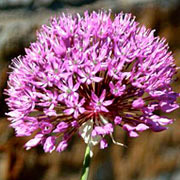 Allium
Allium
The genus Allium, the Latin means 'garlic',
offers colorful, long-lasting forms that are
standouts in the early-summer garden. Tuck
Allium flower bulbs among clumps of summer-flowering
perennials in a sunny location with well-drained,
even sandy, soil. Deer, mice, chipmucks, and related
predators generally avoid them.
 Aubrieta
Aubrieta
Aubrieta "Blue Beauty" Rock Cress is a popular spring-flowering rock garden perennial. It forms a low carpet of evergreen leaves, literally smothered by flowers for several weeks. This selection has flowers of true electric blue. Ideal for the rock garden, cascading over walls, for edging or in alpine containers. This is a vegetative clone, so plants must be increased by division, best done in early autumn. Plants should be trimmed lightly immediately after blooming, to encourage a thick mounding habit.
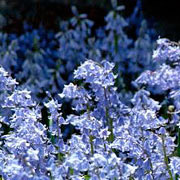 Bluebells
Bluebells
Bluebells are often frequent in ancient woodlands, hedgerows, under bracken and sea cliffs. They are especially frequent in western and upland areas. Although found across the British Isles Bluebells are rare or absent in some areas including parts of East Anglia, western Ireland, northern Scotland, the Orkneys, Shetlands and the Western Isles. Bluebell also occurs as an escape from cultivation, particularly near towns and cities. Bluebells are exceptionally adept in growing in low sunlight areas, and adapt to backyard environments quickly. Thier long running roots go deep, and spread into grassy areas. These flowers are light sensitive in areas where full full sun is present, and will close during high periods of heat. They can be found in mountainous areas of the west coast of North America, and South-West Alaska during the summer months.
 Bouganvilla
Bouganvilla
Bouganvillas are native to Brazil. They were named for Canadian explorer Admiral Louis de Bougainvillea, who traveled across the Pacific Ocean in 1768. Bouganvillas are not actually flowers. However, the colorful displays exhibited by bougainvilleas contain bracts surrounding their small, white, relatively inconspicuous flowers. These types of plants are generally self sustaining and do not need to be watered everyday. Bouganvillas are a great addition to surrounding trellis structures, walls, and areas where coverage is needed.
 Camelia
Camelia
Camellia is a genus of flowering plants in the family Theaceae, native to eastern and southern Asia from the Himalaya east to Japan and Indonesia. Different botanists vary in the number of species considered distinct, with anything from 100 to 250 species being accepted. They are evergreen shrubs and small trees from 2, to 20m tall. The leaves are alternately arranged, simple, thick, serrated, usually glossy, and 3 to 17cm long. The flowers are large and conspicuous, 1, to 12cm diameter, with (in natural conditions) 5, to 9 petals; color varies from white to pink and red, and yellow in a few species. The fruit is a dry capsule subdivided into 1 to 5 compartments, each containing 1 to 8 seeds.The genus is generally adapted to acidic soils, and does not grow well on chalk or other calcium-rich soils. Most species also have a high rainfall requirement and will not tolerate drought. This species of flowers are delicate and tend to spoil if cut early.
 Clematis
Clematis
Clematis are the aristocrat of climbers; their rich hues and varied bloom times enable the gardener to have masses of bloom from late winter to late fall. The blooms of the Clematis often change color, some very markedly through the life of each flower.
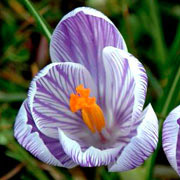 Crocus
Crocus
When it seems like winter will never lose its icy grip, the dainty goblet-shaped crocus pushes through the snow to put on a show of colorful revival. If you are not planting this perennial bulb, you are missing an early season of delight. From snow crocuses (the first to bloom) to giant Dutch crocuses, all just 2 to 4 inches tall, these blooms offer a variety in color (pinks, reds, oranges, yellows, purples, blues, and more) that stand out against the bleak late-winter landscape. Many have strong perfumes that lure bees out of their hives in February or March. Small bulbs like crocus not only provide winter garden color, but they naturalize, meaning that they spread and come back year after year—with minimum care—for an ever-larger display. As as a bonus, deer, squirrels, and rabbits rarely bother early little bulbs.
 Daffodils
Daffodils
Genus Narcissus (Daffodil) These beloved bulbs mainly bloom in late winter and early spring, breaking the spell of winter with their large blossoms saturated in cheery tones. Narcissus naturally occur in meadows, woodlands, along watercourses, and in rocky outcroppings up to subalpine altitudes. The mainly yellow or white flowers are comprised of 6 petals surrounding a corona. Narcissus make superb companions to herbaceous and woody plants, and their uses in the landscape are numerous: in formal spring displays, mixed herbaceous or shrub borders, deciduous woodland plantings, rock gardens, naturalized in large scale meadow plantings or lawns, and in containers or greenhouse displays.
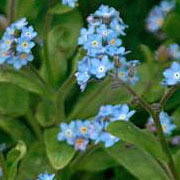 Forget Me Nots
Forget Me Nots
The genus Myosotis includes annuals, biennials, and perennials in about 50 species grown for their charming, small, daisy-like flowers in shades of blue, yellow, or white, often with yellow or white eyes. They are native to woods, meadows, and wet areas of Europe, Asia, Australia, New Zealand, and North and South America. Foliage is thick and grows in clumps or mats. The flowers are the main show. Use forget-me-nots in rock gardens or beds, at waterside, or in a border where they can be appreciated up close. They are especially effective en masse.
 Geraniums
Geraniums
The large blooms of this perennial are a spectacular violet-blue with a white throat and darker venation on plants 1 to 2 feet tall and wide. The attractive foliage weaves itself through neighboring plants. Grow in borders, containers, or rock or cottage gardens. 'Rozanne' is most effective en masse.
 Lavender
Lavender
The genus Lavandula contains a couple of dozen species of aromatic, evergreen shrubs and subshrubs that are cultivated for their spikes of fragrant, tubular flowers on the end of long stalks. They hail from dry, sunny, rocky areas of the Mediterranean, Africa, Asia, and India. Leaves are small, densely clustered, and often grayish green. Grow lavender in a border, rock garden, as edging or hedging, or in containers. Flowers and leaves can be dried for a variety of uses. Noteworthy characteristics: Aromatic. Spikes of fragrant flowers which attract bees and butterflies.
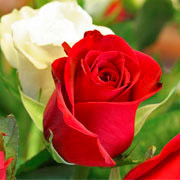 Roses
Roses
From rose aficionado to rose novice, there's one of these beautiful bloomers for every type of gardener. Whether you're planting just one bush or a whole bed of these stunning flowers, you'll need a bit of background, including understanding the importance of condition and location, as well as smart ways to care for your plants. A good start is understanding the differences between container-grown and bare-root roses. We help you learn how to shop for roses -- a key skill for success -- as well as how to propagate and hybridize your own plants. As with all other flowers, pruning, watering, and feeding are important; our basic care guide will help you understand the particulars of rose care, including how to protect your roses from pests and diseases (especially the dreaded black spot). Many roses require more tending, but for no-fuss varieties, we have the best shrub roses (which also happen to be fairly disease-resistant, too).
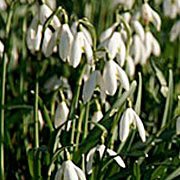 Snowdrops
Snowdrops
Few flowers are more appreciated than the first blossoms of spring, promising as they do a season of sunshine and renewal after the long, gray winter months. Always among the first to appear are snowdrops, their dainty bells of pale ivory and jade blooming close on the heels of winter aconite and before most crocuses.
 Tulips
Tulips
Tulips originate in regions with cold winters and dry summers. (They require a cold treatment in order to bloom.) They are invaluable for early spring color in bedding schemes, parterres, cottage gardens, and mixed borders. Smaller species are suitable for rock gardens. Many only last and bloom reliably for one season (best treated as annuals, or lifted six weeks after blooming, dried, with only the largest bulbs replanted), but some of the species will naturalize. Many are suitable for forcing. Tulips are grouped into 15 divisions: Single Early, Double Early, Triumph, Darwin Hybrid, Single Late, Lily-flowered, Fringed, Viridiflora, Rembrandt, Parrot, Double Late, Daufmanniana, Fosteriana, Greigii, and Miscellaneous.
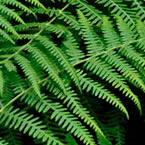
Ferns are are a great coverage plant for all areas!
Ferns require less light than most plants since their origin is based in areas where low light is predominent. Decorative leaves adorn this plant, and make a nice addition to front yard sections.
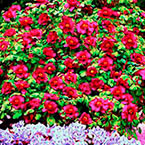
Peonys add a splash of color to any garden
Easy to plant and care for, these flowering plants offer a bright addition to any yard garden. Large blooms in vibrant colors are the trademark for this plant.
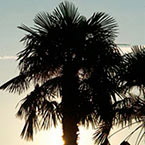
Palms are a Californian trademeark tree!
Palms offer partial shade to large areas, and accent open spaces where needed. They offer low maintenance for small varieties. These trees add a stylish accent to any home.
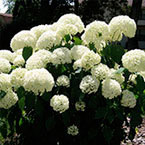
Hydrangeas are the flowers of Springtime!
Once a year, these beautiful flowers sprout new stems, and produce full bodied flowers with round bulb shaped blooms. A variety of colors are available in our nursery, and can be kept as bulbs for storage when seasons permit planting.
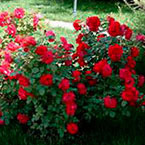
Rose bushes are the accent to any front yard!
Producing small to large blooms on a continual basis throughout Spring and late Summer, these plants offer a secondary accent to back or front yards.
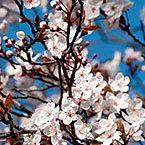
We Love Apple Trees!
Barney's Plant Nursery offers over 23 different plant seedlings of apples. Macintosh, Wasington, Granny Smith, and Fugi are just some of the many we have in stock. Planting these trees in the best soil possible using Barney's A1 Fertilizer helps boost growth, and protects against ground inhibiting conditions.

California Cactus Anyone?
Low in maintenance and very easy to care for, these plants offer a low cost way to accent any yard area. We currently have in stock over 25 different varieties of cactus in all shapes and sizes.
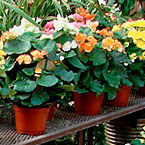
Potted plants for every area around the house!
A quick and easy way to add a splash of color to any room, patio, or front deck area. Maintenance on a weekly basis is all that is needed. Pick a few up today!

 Garden Tools
Garden Tools 
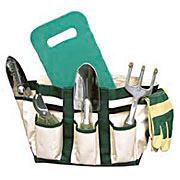 Garden Tool Bag
Garden Tool Bag
Our premier garden tool bags are the perfect additon to any gardeners toolset. When you need to carry tools into hard to reach areas and need easy access to the tools you want, our premier garden tool bag has several pockets to store any small tool needed. Made of sturdy canvas, and re-inforced seams, this product is durable, and made to last. We carry a five year guarantee with every purchase or your money back.
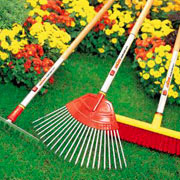 Rakes and Push Brooms
Rakes and Push Brooms
Barney's Plant Nursery offers a full line of garden rakes to suit every job in the garden, lawn or planting site. Made of cast iron, and solid oak wood handles, these products are designed to take wear and tear, and are guaranteed to last for the life of the product. If you are not satisfied with the product for any reason, we will replace it free of charge. All our push brooms come in a variety of sizes to suit every job. We have specialty brooms that are wide enough for big jobs as well!
 Gloves
Gloves
Barney's Plant Nursery offers free gloves for every garden class we offer! (Limit one pair per customer)
We carry 25 different types gloves for gardening and general tool use. We carry gloves in a variety of sizes to fit, and a generic “one size fits all” for general purposes. Our nursery also carries household gloves for indoor cleaning purposes in latex and soft cotton material.
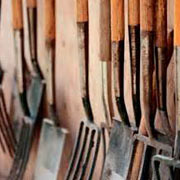 Shovels and Pitchforks
Shovels and Pitchforks
Our nursery carries over fourty different type of shovels and pitchforks suited for gardening needs. Made of solid oak or birch wood handles, and cast iron spades, these products are designed to last. We carry a five year warranty for each item, and include a money back gaurantee if you are not satisfied with your purchase. Ask any one of our sales associates for free training on the safe use of these items, and we will give you 10% Off your purchase!
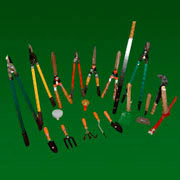 Specialty Tools For Your Garden
Specialty Tools For Your Garden
We carry over 300 types of tools for weeding, digging, trenching, and general use! Ask any of our store associates for help on finding the tool you need. Our product line includes clippers and saws for
trimming and cutting foliage and trees. All of our tools come with a 1 year guarantee, so if you are not satisfied for any reason, we will refund your money no questions asked.